
Robinia pseudoacacia, commonly known in its native territory as black locust, is a medium-sized hardwood deciduous tree, belonging to the tribe Robinieae of the legume family Fabaceae. It is native to a few small areas of the United States, but it has been widely planted and naturalized elsewhere in temperate North America, Europe, Southern Africa and Asia and is considered an invasive species in some areas, such as the temperate east coast of Australia where the cultivar "Frisia" was widely planted as a street tree before being classed as a weed. Another common name is false acacia, a literal translation of the specific name.

The insects of the beetle family Chrysomelidae are commonly known as leaf beetles, and include over 37,000 species in more than 2,500 genera, making up one of the largest and most commonly encountered of all beetle families. Numerous subfamilies are recognized, but the precise taxonomy and systematics are likely to change with ongoing research.

The Asian long-horned beetle, also known as the starry sky, sky beetle, or ALB, is native to the Korean Peninsula, northern and southern China, and disputably in northern Japan. This species has now been accidentally introduced into the eastern United States, where it was first discovered in 1996, as well as Canada, and several countries in Europe, including Austria, France, Germany, Italy and UK.

Hylotrupes is a monotypic genus of woodboring beetles in the family Cerambycidae, the longhorn beetles. The sole species, Hylotrupes bajulus, is known by several common names, including house longhorn beetle, old house borer, and European house borer. In South Africa it also is known as the Italian beetle because of infested packing cases that had come from Italy. Hylotrupes is the only genus in the tribe Hylotrupini.

Cleridae are a family of beetles of the superfamily Cleroidea. They are commonly known as checkered beetles. The family Cleridae has a worldwide distribution, and a variety of habitats and feeding preferences.
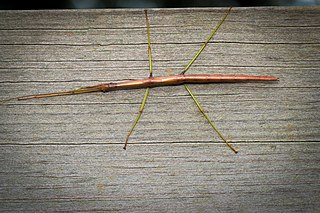
The common walkingstick or northern walkingstick is a species of phasmid or stick insect found across North America. The average length of this species is 75mm (3 in) for males and 95mm (3.7 in) for females.

The wharf borer, Nacerdes melanura, belongs to the insect order Coleoptera, the beetles. They belong to the family Oedemeridae, known as false blister beetles. Wharf borers are present in all the states of the USA except for Florida. It takes about a year to develop from an egg to an adult. The name 'wharf borer' comes from the larval stage of this insect, which often lingers on pilings and timbers of wharves, especially along coastal areas. The adult beetles are identifiable via a black band across the end of both elytra. In addition, wharf borers are distinct from other members of the family Oedemeridae due to the presence of a single spur on the tibia of the forelegs and the distance between both eyes. The female beetle oviposits eggs on rotten wood, on which the larvae hatch, burrow, then feed. Adults do not eat and depend on stored energy reserves accumulated as a larva. They are considered a pest because they damage wood used in building infrastructures.

Xanthocryptus novozealandicus, the lemon tree borer parasite, is a wasp in the family Ichneumonidae. It is a native insect of New Zealand. It is also found in Australia and New Guinea. Females hunt for larvae of wood-boring beetles around March, including the lemon tree borer, a native cerambycid that tunnels into citrus trees, grapes and many native species. When a suitable host is found, the female pushes her ovipositor through the wood and injects her eggs into the grub. This has the incidental benefit of helping to control some pests. X. novozealandicus prefers to prey on second year lemon tree borer larvae. This specific parasite prefers to prey on larger second year larvae due to its larger size.
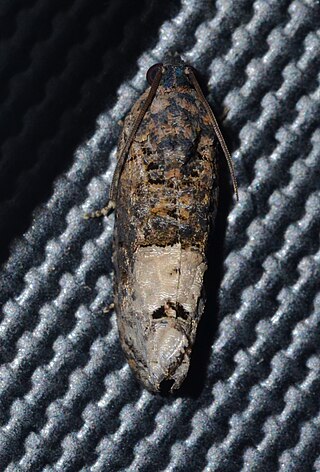
Ecdytolopha insiticiana, the locust twig borer is a moth of the family Tortricidae. It is found in North America, including Pennsylvania, Iowa, West Virginia, Arkansas, Massachusetts, New York and Ontario.

The Banded Alder Borer is a member of the very diverse family of longhorn beetles.

The cottonwood borer is a species of longhorn beetle found in the United States east of the Rocky Mountains that feeds on cottonwood trees. It is one of the largest insects in North America, with lengths reaching 40 millimetres (1.6 in) and widths, 12 mm (0.47 in). It is the only species in the genus Plectrodera.

Megarhyssa nortoni, also known as Norton's giant ichneumonid wasp or the western giant ichneumonid wasp, is a species of large ichneumon wasp.

Prionus californicus, commonly known as the California root borer, is a species of insect in the longhorn beetle family (Cerambycidae). It is native to the American west where it is often a pest of orchard and vine crops.

Phoracantha semipunctata, the Australian Eucalyptus longhorn, is a species of beetle in the family Cerambycidae. Native to Australia, it has now spread to many parts of the world, including practically all countries where tree species of Eucalyptus have been introduced. It has been classified as an invasive pest species of Eucalyptus outside Australia.

Platypus apicalis, known by its common name the New Zealand pinhole boring beetle, is a wood-boring beetle endemic to New Zealand and found throughout the North and South Island in a range of environments.

Xylosandrus compactus is a species of ambrosia beetle. Common names for this beetle include black twig borer, black coffee borer, black coffee twig borer and tea stem borer. The adult beetle is dark brown or black and inconspicuous; it bores into a twig of a host plant and lays its eggs, and the larvae create further tunnels through the plant tissues. These beetles are agricultural pests that damage the shoots of such crops as coffee, tea, cocoa and avocado.
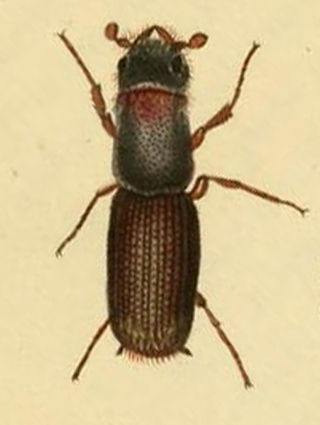
Platypus cylindrus, commonly known as the oak pinhole borer, is a species of ambrosia beetle in the weevil family Scolytinae. The adults and larvae burrow under the bark of mature oak trees. It is native to Europe.
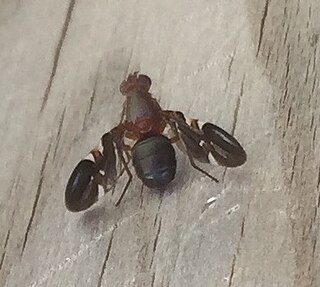
Delphinia picta is a species of picture-winged fly in the family Ulidiidae. The specific name picta is from Latin and means "painted." It is the only species in the monospecific genus Delphinia. It is found in the United States on the East Coast and in the Midwest from Florida to Maine across to Kansas through Minnesota but also can be found in Mexico and El Salvador. It is sometimes mistaken for a species of fruit fly, but D. picta do not feed on living plant matter, as they are detritivores and eat decaying plant matter. They also have been observed eating fermenting frass from Megacyllene robiniae on black locust trees. They can be found almost anywhere there is decaying vegetation: landfills, temperate deciduous forests, swamps, and even shaded fields.

Oemona hirta, the lemon tree borer, also known as the whistling beetle or the singing beetle, is a longhorn beetle endemic to New Zealand. Its larvae are generalist feeders, boring into the wood of a wide variety of trees, native and introduced. When citrus orchards were first established in New Zealand, this beetle started inflicting serious damage, and so gained the name "lemon tree borer". Four species within the genus Oemona have been identified, suggesting that more species could be found. When disturbed by predators or humans, the adult beetle stridulates creating a "rasp" or "squeak" sound by rubbing its thorax and head together against an area of thin ridges. Māori would eat a liquid called "pia manuka", which was produced by manuka trees when its wood was damaged by the larvae. When Captain Cook first arrived in NZ, his naturalists, Banks and Solander, collected a lemon tree borer in their first collection between 1769 and 1771. This oldest collected specimen can be found in the British Museum. A few years after the first collection, the species would be first described by the Danish naturalist Fabricius in 1775.
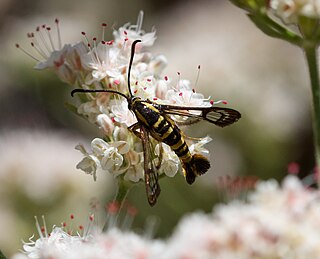
Synanthedon resplendens, also known as the sycamore borer moth, is species of a clearwing moth native to western North America. Larva of this moth live under the bark of sycamore, ceanothus, coast live oak, and, on rare occasions, avocado trees. Sycamore hosts include California sycamore, Arizona sycamore, and American sycamore trees. Coast live oak is a confirmed host, but this moth likely uses many or most other western oaks as well.





















